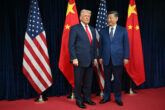August 01, 2024
The Rise and Fall of the Economic Pivot to Asia
For more than two centuries, the United States was a Europe-first power. In 2011, however, the Obama administration announced a change to America’s strategic orientation. Asia would henceforth serve as its priority region, and the United States would refocus its military, diplomatic, and economic emphasis on the Indo-Pacific. This move—the pivot to Asia—would tap into Asia’s dynamism, respond to China’s astonishing rise, end Middle East wars, and limit security expenditures in Europe. The notion quickly won support among policymakers in both parties and across subsequent administrations. It coupled sound strategic logic with a keen appreciation of the ways in which the world was changing.
Our new book, Lost Decade: The U.S. Pivot to Asia and the Rise of Chinese Power, tells this story, including its economic dimension. Capitalizing on Asia’s economic promise was key to the approach from the outset. By 2008 the unique economic potential in the Asia-Pacific, which accounted for 40 percent of global growth, was undeniable. By the early 2010s the notion of an “Asian century” had become commonplace, referring mostly to the eastward shift of global economic gravity. The pivot’s architects naturally wished to harness this dynamism for American benefit.
The notion of Chinese political liberalization through trade and globalization was abandoned years ago.
Most U.S. policymakers also subscribed to the notion of a causal link between economic growth and liberal governance, especially in China. “As we grow our economies,” President Barack Obama said, “we’ll also remember the link between growth and good governance—the rule of law, transparent institutions, the equal administration of justice. Because history shows that, over the long run, democracy and economic growth go hand in hand.” Successfully engaging in commerce, it was thought, required the kinds of institutions and practices characteristic of democratic government, and a rising middle class would eventually demand basic rights and liberties.
Asia’s own trade liberalization also drove American economic interest. By the early 2010s, with global trade talks (via the World Trade Organization’s Doha Round) going nowhere, countries in the region increasingly pursued their own deals. In 2000, for example, Asia had just three free trade agreements in effect. By 2011 the number had exploded to around 50, with another 80 in progress. In November 2011, the year the U.S. pivot was announced, the idea of the Regional Comprehensive Economic Partnership (RCEP) first appeared at the ASEAN Leaders Summit in Bali. Amid this flurry of activity, however, America was on the outs: With the exception of the Korea Free Trade Agreement, the United States was party to none of these deals. It was time to get in the game, many policymakers thought, or be left behind in a region on the move.
Read the full article from Foreign Policy.
More from CNAS
-
Indo-Pacific Security / Energy, Economics & Security
North Korea’s Provocations, Power Plays, and Shifting AlliancesTensions on the Korean Peninsula have reached a new and dangerous threshold. President Lee Jae Myung is warning of a real risk of accidental military clashes, as the situation...
By Dr. Go Myong-Hyun
-
Transatlantic Security / Middle East Security / Energy, Economics & Security
Sanctions Aren’t Enough to Shut Down the Moscow-Tehran Black Market for WarThe geographic scope and extent of Iranian-Russian cooperation highlights the failure of traditional sanctions to prevent Moscow and Tehran from seeking key components like ch...
By Delaney Soliday
-
Indo-Pacific Security / Energy, Economics & Security
How to Win the Economic War with ChinaTrump's approach to China has run aground, giving Beijing unprecedented advantage in the economic conflict....
By Edward Fishman & Julian Gewirtz
-
Indo-Pacific Security / Technology & National Security
Sharper: Tech + ChinaRecent talks between President Donald Trump and Chinese Communist Party General Secretary Xi Jinping placed a spotlight on emerging technologies, from high-end chips to minera...
By Charles Horn & Sevi Silvia




